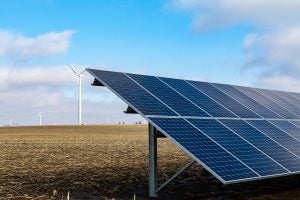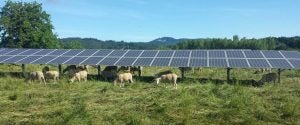“Solar boom covers farmland that could feed millions,” reads an environmental news headline in the July 6 issue of New Scientist. The author, Madeleine Cuff, goes on to say the “huge numbers of panels being installed on prime farmland (worldwide is) taking quadrillions of calories out of the global food supply.”
Solar farms installed in deserts or low value pasture lands has always been the textbook image portrayed. Now they are here in force, and builders want to put them on nice, flat land close to existing transmission lines and roads. I can’t really blame them. It’s much easier to build roads and install posts if you have flat — or nearly flat — rock-free, deep soil to work with.
The Department of Energy estimates that the U.S. will need 10 million acres of solar panels by 2050 to meet net zero-carbon goals. That estimate is likely way low, considering the power requirements of data processing centers. According to reporting from the Wall Street Journal, the International Energy Agency “projects that artificial intelligence’s energy usage will rise ten-fold over the next two years.” Some data centers can use as much as 65 megawatts, enough for 65,000 homes. By 2030, data centers are “expected to comprise 16% of total U.S. power consumption,” CNBC wrote.

Some people argue that 40 percent of corn acres are used for ethanol production — about 36 million acres — so if all the 10 million acres needed were converted from corn fields, who would miss it? For one, a bunch of cattle feeders that rely on the high protein feed left over from the fermentation process.
The acres won’t all come from corn, of course, but the point is, 10 million acres can be spared. But how many acres will it really take? Maybe 100 million? We better build some nuclear power plants soon.
The U.S. Interior Department says it will install solar panels above irrigation canals. A good idea. Shade the water and cut down evaporation.
New York City has 40,000 acres of roof tops that could harbor solar panels. Add every other big city and you have a good start on 10 million acres.
In California, rooftop solar is everywhere. Ten percent of California’s power is supplied by home installed solar. Fourteen percent is supplied by commercial projects. California now has so much renewable power, including wind and hydro, that they can’t always use it all when solar generation is at its midday peak. And the grid won’t always handle their need to export, so something has to be shut down. (That sometimes happens in the Pacific Northwest also.) In the first half of 2024, shut downs amounted to “2.6 million megawatt-hours of renewable energy–most of it solar–, more than enough to power all the homes in San Francisco for a year.”
California instituted incentive programs to install rooftop solar in 1995, and they have been almost too successful. Last April they reduced the incentives and now installation is not cost-effective unless storage batteries are also installed. But that can cost $10,000 to $20,000 more.
Huge solar projects are in the works across the U.S. and the world. In Washington State, Gov. Jay Inslee has used his “big stick” to force through a large project in the Horse Heaven Hills near the Tri-Cities. The plan is to install 222 wind turbines and over 5,000 acres of solar panels. I wonder if anyone has told the developers that Eastern Washington has anywhere from three to four months of overcast or fog, or both, in the winter, and a couple months of smoke in the summer. And you can’t count on windmills to pick up the slack. Wind tends to not blow much in that kind of weather.
The largest solar farm in the U.S., named the Mammoth Solar Farm, is under construction in Indiana. It will cover 13,000 acres across two counties, Starke and Pulaski, and when complete it will have a capacity of 1.3 gigawatts (1,300,000,000 watts), enough to supply 1.3 million homes at peak power. At night, zero homes, unless some sort of power storage is provided.

The project is planned to be dual use. The farmers who have leased the land to the project will continue to farm under the panels, grazing sheep, cattle and other animals, and growing crops such as corn, hay, melons and blueberries. At first glance, this seems like a win-win situation. But it remains to be seen if field crops, such as corn, can be efficiently grown in such cramped conditions. If not, and all future project acres are converted to pasture, do we really need more millions of grass-fed beef and lamb belching methane? That defeats the goal of carbon neutrality.
Solar power has a couple of serious drawbacks. As more comes on line, the wholesale price of solar power during peak production hours can get so low power suppliers can no longer turn a profit. California is approaching that limit now, with power prices falling as low as 5 cents a kilowatt in the middle of the day vs. $1 at times of peak demand in the evening.
Another drawback is disposal when the useful life of the panels — about 30 years — ends. Most will end up in landfills where toxic metals — such as lead, silver and cadmium — could leach into ground water. About 80 percent of a panel is recyclable, but it costs $20 or more to do that vs. $1 to $2 to dump it in a landfill.
Used windmill blades are already a disposal problem. Seems nuclear power is not the only power producer with a waste problem.
Jack DeWitt is a farmer-agronomist with farming experience that spans the decades since the end of horse farming to the age of GPS and precision farming. He recounts all and predicts how we can have a future world with abundant food in his book “World Food Unlimited.” A version of this article was republished from Agri-Times Northwest with permission.



